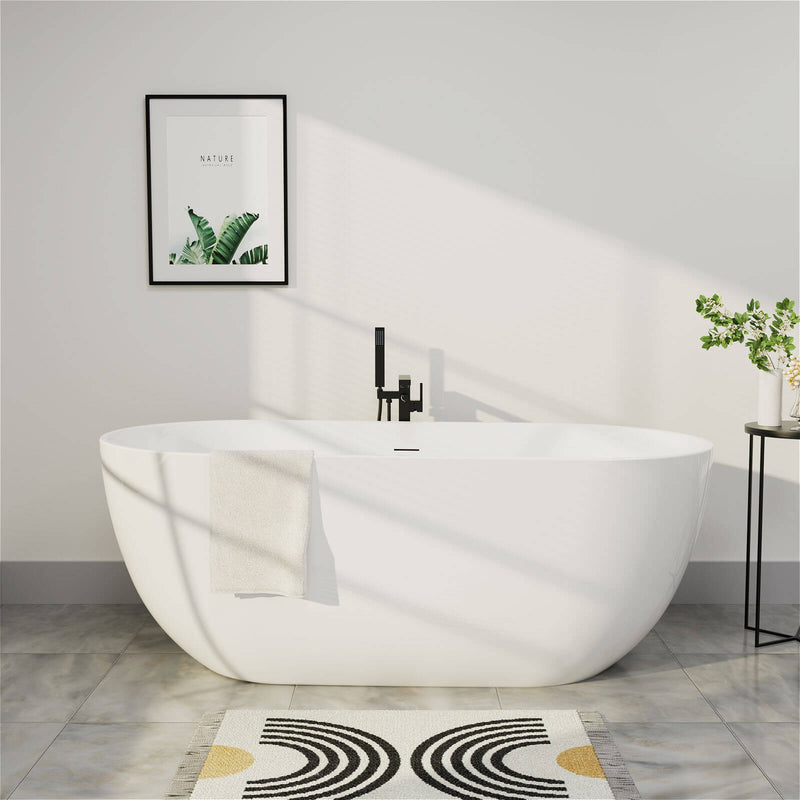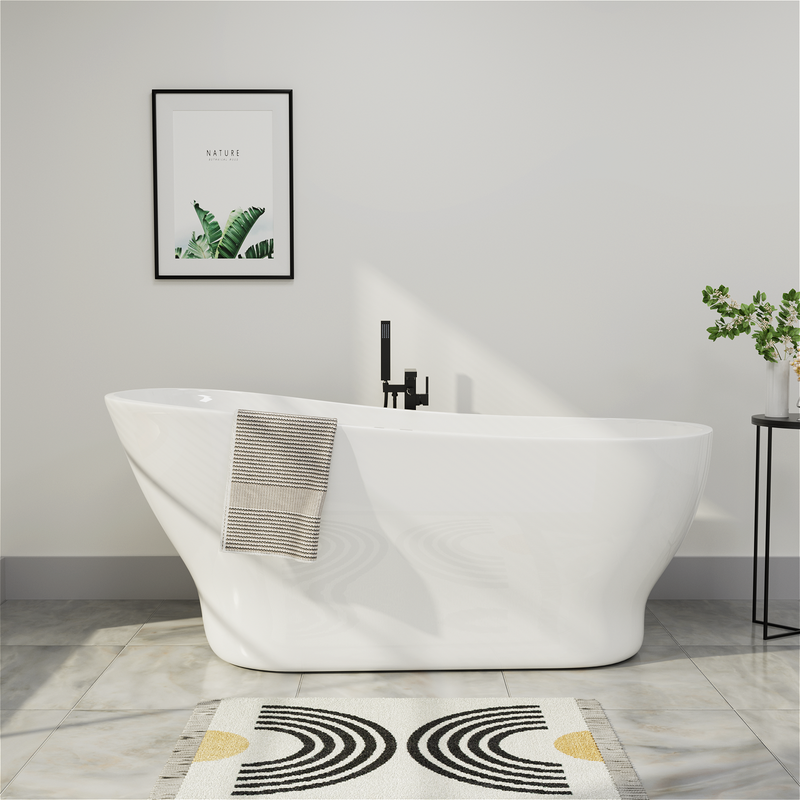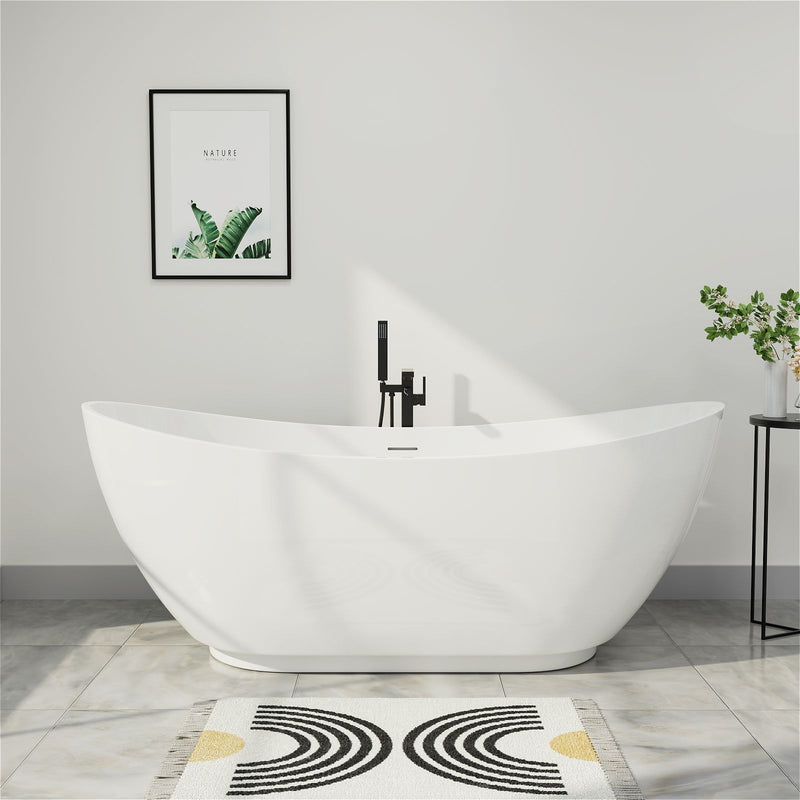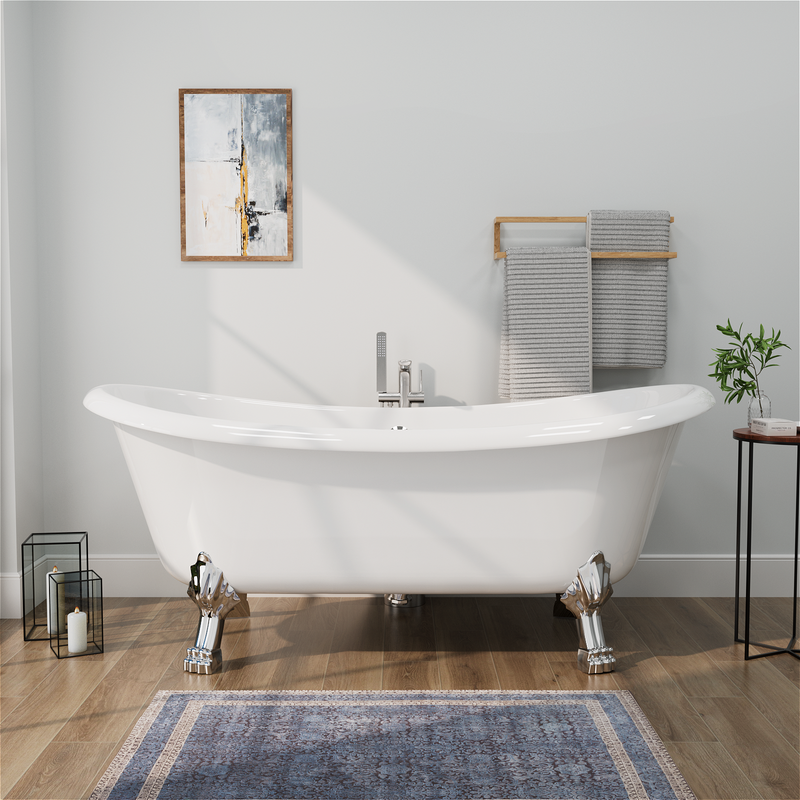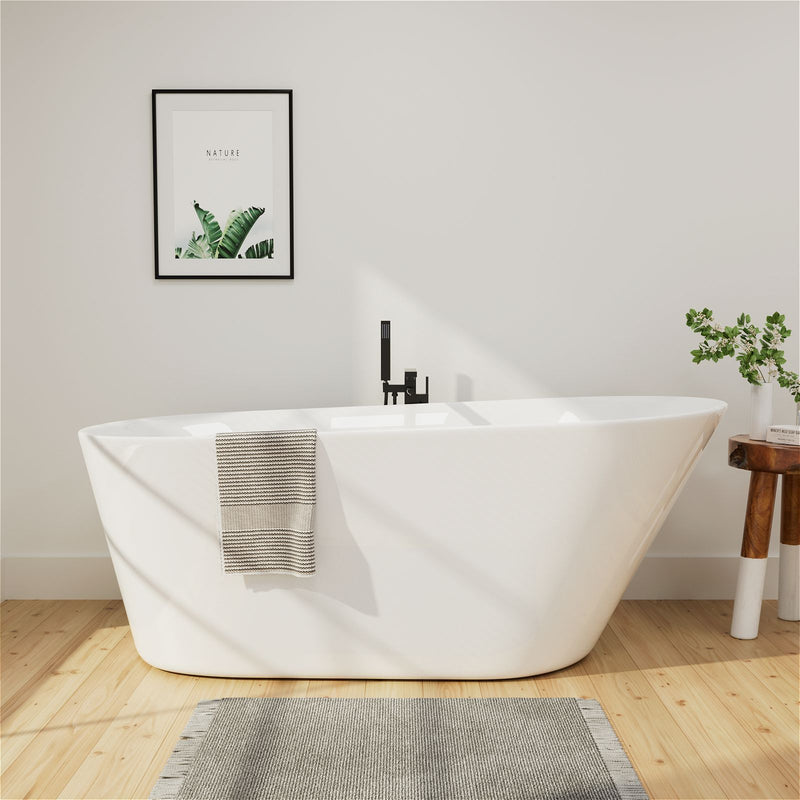In modern home renovation, the choice of bathtub often puts people in a dilemma - should they choose a warm and skin-friendly acrylic bathtub or a sturdy and durable steel bathtub? These two mainstream materials have their own advantages, from the touch experience to the thermal insulation performance, from the installation and maintenance to the service life, each aspect affects the final bathing experience and long-term use satisfaction. This article will compare the differences between acrylic and steel bathtubs from eight dimensions to help you make the most personal choice based on the understanding of the material characteristics. Whether you are decorating a new house or planning to renovate an old bathroom, this comprehensive comparison guide will be a good helper in your decision-making process.
Material Characteristics and Touch Experience
When people stand at the crossroads of bathroom decoration and face the choice between acrylic and steel bathtubs, the first thing they feel is the completely different material characteristics of the two. Acrylic bathtubs immediately win the favor of many people with their warm touch. This synthetic material can maintain a pleasant surface temperature at room temperature, and will not give people a cold stimulation like metal. Its surface smoothness is just right, neither too slippery to make people uneasy, nor rough and uncomfortable. In contrast, the initial touch of a steel bathtub is significantly colder, especially in winter, when the chill at first contact often takes some time to be neutralized by body temperature.
The elastic modulus of acrylic gives it a unique "soft" property, which produces a slight cushioning feeling when the human body comes into contact with it. This subtle elasticity reduces the discomfort caused by accidental collisions. The steel bathtub is completely the opposite. Its rigidity means that any contact is direct and clear. From the material sound feedback, gently tapping the acrylic bathtub will make a dull sound, while the steel bathtub will respond with a crisp metallic sound. This acoustic difference will also affect the user's psychological feelings.
Comparison of Thermal Insulation Performance and Energy Consumption
One of the core elements of the bathing experience is the persistence of water temperature. In this regard, the difference between the two materials is particularly significant. The thermal conductivity of acrylic is about 0.2 W/(m·K), while the thermal conductivity of steel is as high as 50 W/(m·K), which means that the heat of the steel bathtub dissipates much faster. In actual use, an acrylic bathtub filled with hot water can maintain a suitable temperature for up to 1-2 hours, while a steel bathtub under the same conditions may cool down significantly within 30-40 minutes. For people who like to take a long bath, this difference is enough to affect their choice decision.
This difference in insulation properties is also directly related to energy consumption. In order to maintain the water temperature, users of steel bathtubs often need to add hot water more frequently or increase the water temperature at the beginning, which will increase the energy consumption of the water heater. Acrylic bathtubs can save considerable hot water costs in long-term use due to their excellent insulation performance. It is worth noting that some high-end steel bathtubs will improve this shortcoming by adding insulation layers, but this usually significantly increases the price of the product.
Installation and Daily Maintenance
From an installation perspective, steel bathtubs are usually heavier than acrylic bathtubs, which brings additional challenges to handling and installation. A standard-sized steel bathtub can weigh up to 100-150 kg, while an acrylic bathtub of the same size may only weigh 50-70 kg. This weight difference is particularly important in older homes or high-rise apartments, where the load-bearing capacity of the floor may be a limiting factor. During installation, steel bathtubs require a higher level of support structure, and the base needs to be completely flat to avoid the risk of deformation caused by stress concentration.
In terms of daily cleaning and maintenance, acrylic surfaces are relatively resistant to water stains and soap scum, and can be easily cleaned with ordinary bathroom cleaners. However, it is more sensitive to scratches and may leave fine scratches when using hard cleaning tools. Steel bathtubs are usually specially treated to resist scratches, but areas with hard water are prone to scale deposits, which need to be removed regularly with acidic cleaners. Both materials may show surface aging after long-term use, acrylic may slightly yellow, and steel surface coatings may develop fine cracks.
Design Diversity and Space Adaptation
The thermoplasticity of acrylic gives designers great creative freedom. The material can be bent into a variety of complex shapes by heating. Bold acrylic bathtubs can be seen on the market - some resemble unfolding petals, some imitate organic forms in nature, and others adopt avant-garde asymmetrical designs. This versatility allows acrylic bathtubs to adapt to a wide range of decor styles, from traditional to ultra-modern. Freestanding acrylic bathtubs are particularly popular, and they can become the visual focal point of the bathroom, or even be placed by the window to create a unique bathing experience.
Steel bathtubs are limited by the metal forming process, and the shape options are relatively limited, mainly in classic rectangular and oval shapes. However, this material can achieve a slim edge effect that acrylic cannot achieve, creating a clean and neat modern feel. The surface treatment process of steel bathtubs is also constantly innovating, from traditional high-gloss chrome plating to current matte, texture and other effects, bringing different visual temperatures to the space. In small apartments, steel bathtubs are usually easier to fit closely to the wall, saving valuable space.
Durability and Long-Term Use Costs
In terms of service life, high-quality steel bathtubs tend to have a longer theoretical service life, which can reach more than 20 years with proper maintenance. Steel itself has high strength and hardness, excellent impact resistance, and is not prone to structural damage. The average service life of an acrylic bathtub is usually between 10-15 years. Although modern acrylic materials have improved impact resistance by adding reinforcement layers, they may still show slight deformation or surface wear after long-term use.
Long-term cost calculations need to consider multiple factors. Although the initial purchase cost of a steel bathtub is usually higher, its longer service life may dilute the average annual cost. Acrylic bathtubs have a lower initial investment, but may need to be replaced earlier. It is worth noting that bathtub replacement is not only the cost of the product itself, but also includes the labor and auxiliary material costs of removing the old bathtub and installing the new bathtub. These hidden expenses should also be taken into consideration. Differences in energy bills As mentioned earlier, acrylic bathtubs can save considerable hot water costs in long-term use.
Safety and Comfort Considerations for Use
Bath safety is an important consideration in home bathroom design, and the two materials have their own characteristics in this regard. Acrylic's natural elasticity allows it to provide a certain buffer in the event of a collision, reducing the risk of injury, which is particularly suitable for families with elderly people and children. Its surface temperature is close to room temperature and does not pose a risk of scalding. The edges of steel bathtubs are usually thin and hard, and accidental collisions may be more painful, but high-quality steel bathtubs will be rounded at the edges to reduce the risk.
In terms of comfort, the gentle touch of acrylic makes it more comfortable to lean on for a long time without a "scratching" feeling. Although steel bathtubs feel cold at first, once the water temperature stabilizes, the metal can provide uniform heat conduction, and some users prefer this direct thermal conductivity. For arthritis patients or people with muscle soreness, both materials can provide good support, but the slight elasticity of acrylic may make the body pressure more evenly distributed.
Environmental Properties and Sustainability
Today, with increasing environmental awareness, the ecological properties of bathtub materials are also worthy of attention. As a petroleum-based product, acrylic has high energy consumption and carbon emissions in the production process, but modern acrylic bathtubs usually contain a certain proportion of recycled materials. After the end of its service life, acrylic can theoretically be recycled and reused, but the actual recycling channels are not yet perfect. The main raw material of steel bathtubs is iron ore, and the smelting process is also energy-intensive, but steel has almost unlimited recycling possibilities, and the existing recycling system is relatively mature.
From a life cycle assessment, steel bathtubs may have a slight environmental advantage, especially when their service life is fully utilized. However, this gap may be partially offset by the energy saved by acrylic bathtubs during the use phase. Consumers who are particularly concerned about environmental protection can also look for products with environmental certification. Regardless of the material, there are now manufacturers committed to reducing the environmental impact during the production process.
Market Trends and Consumer Preferences
Current market data shows that acrylic bathtubs occupy a large share in the new residential and renovation markets, mainly due to their price advantage, variety of shapes and ease of installation. Steel bathtubs maintain stable demand in the high-end market and specific design styles, and their fans appreciate the unique texture and durability of metal. In recent years, both materials have been evolving - acrylic has improved its strength through composite materials, and steel bathtubs have improved their touch through surface treatment.
Consumer choices are often influenced by multiple factors. Families with limited budgets usually tend to prefer acrylic, while buyers who value long-term value may choose steel. Design-sensitive consumers will decide based on the overall decoration style. Modern minimalist styles may prefer the neat lines of steel, while natural styles may be more suitable for the organic forms of acrylic. Regional factors should not be ignored. In cold climates, the thermal insulation performance of acrylic is more valued; in humid environments, the moisture-proof properties of steel may be more attractive.
Comprehensive Recommendations and Selection Guide
When it comes to choosing between acrylic and steel bathtubs, there is no absolute good or bad. The key is to match personal needs and specific situations. For consumers who pursue cost-effectiveness, diverse shapes and warm touch, acrylic bathtubs may be a more suitable choice. Users who value extreme durability, modern aesthetics and long-term value may prefer steel bathtubs.
When making actual decisions, it is recommended to consider the following factors: family composition (especially whether there are elderly and children), frequency and duration of use, decoration style positioning, budget range, bathroom space conditions, etc. If possible, it is best to experience samples of both materials on site to experience the touch and sitting comfort in person. At the same time, do not ignore the installation requirements to ensure that the conditions at home are suitable for the selected bathtub type. No matter which material is finally chosen, high-quality installation and correct daily maintenance can significantly extend the product life and enhance the user experience.
FAQs
Is the acrylic bathtub easy to scratch? How to maintain it daily?
The surface of high-quality acrylic bathtubs is scratch-resistant, but it is still recommended to use a soft cloth and non-abrasive cleaners. Avoid using hard cleaning tools such as steel wool, and use special care agents regularly to maintain the surface gloss.
Will steel bathtubs be very cold in winter?
Steel bathtubs do feel cooler at first, but they will quickly conduct heat after being filled with hot water. You can choose a model with an insulation layer, or add a non-slip insulation pad to the edge of the bathtub to improve this problem.
Which bathtub is more suitable for small-sized bathrooms?
Acrylic bathtubs are usually lighter, have more styling options, and can better adapt to irregular spaces. However, some steel bathtubs with thin-edge designs can also save space, so it is recommended to choose according to the specific size.
Which bathtub is more likely to look old after long-term use?
Acrylic may appear slightly yellowed, and the steel surface coating may produce fine cracks. However, high-quality products can remain in good condition for many years under normal use and maintenance, and you should pay more attention to brand craftsmanship when choosing.
If there are elderly and children at home, which material is more recommended?
Acrylic's anti-slip and elastic properties are more suitable for families with elderly and children, and can reduce accidental collision injuries. But no matter which one you choose, you should ensure that safety facilities such as anti-slip mats are installed.
Is there a big price difference between the two bathtubs?
Entry-level acrylic bathtubs are usually cheaper, but high-end acrylic products may be comparable to steel bathtubs. It is recommended to consider the service life and maintenance costs instead of just looking at the initial purchase price.
Can I install it myself or do I have to hire a professional?
Steel bathtubs usually require professional installation due to their heavy weight. Although acrylic bathtubs are lighter, they involve water pipe connections and waterproofing. Unless you have relevant experience, it is recommended to hire a professional to install them.

